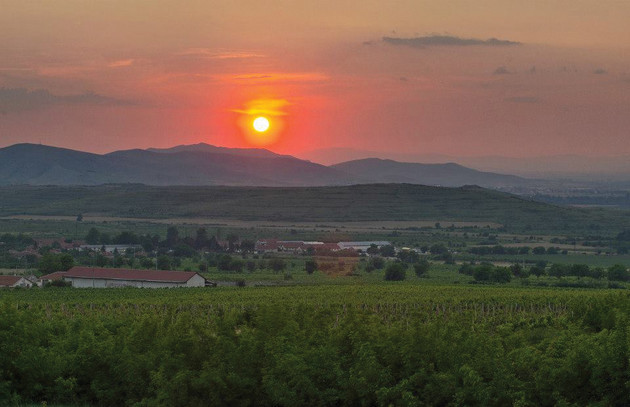
Friday read: New CEE tasting soon to land in London
Justin Keay contemplates the potential impact of the coming showcase for Central and Eastern European wines.
On 18 June London sees one of this year’s most ambitious wine tastings as producers from 15 countries gather in St John’s Church in Waterloo for the Ultimate CEE Wine Fair. After mostly one country tastings devoted to Hungary, Bulgaria (Thracian Lowlands), Georgia, Moldova, Ukraine and Armenia in recent months, this event should take interest in emerging European wine to another level.
“This is almost certainly a world first and definitely a UK first. I don't believe anyone else has ever tried to bring as many wine countries from this region together,” says Caroline Gilby MW, who together with Zsuzsa Toronyi of Wine Communication has organised the tasting, and will be giving two Masterclasses. She says they want to open the eyes of the trade and consumers to the transformation in winemaking in these countries.
“I've seen in person what amazing developments have been taking place, after a difficult previous era - and wine quality is now world class.”
Central and Eastern Europe has evolved into one of the world’s most dynamic wine regions. The completion of post-communist land reforms and the subsequent emergence of a new generation of dedicated young winemakers, largely focused on working with indigenous grapes, has given each country a distinct USP.
Hungary has transformed Furmint - traditionally used for sweet Aszu wines - into a whole new white wine category, Dry Furmint, and is also taking part in the ongoing renaissance of CEE’s blue grape, Blaufrankisch (Kekfrankos). The Czech Republic and Slovakia are using rare indigenous and piwi grapes to make fresh, trendy wines, including in pet nat styles. Romania - the region’s largest producer with Cremele Recas, established by Bristol-born Philip Cox, now CEE’s biggest wine exporter - and Bulgaria have plotted their own viticultural renaissance working with varieties like Romania’s Feteasca Neagra, Feteasca Alba and Zghihara, and Bulgaria’s Mavrud, Melnik, Dimyat and Keratsuda.
Meanwhile the countries of former Yugoslavia have seen a reawakening of their wine industries after years of neglect and underinvestment, led by Croatia and Slovenia, with producers working with native varieties like Malvasia Istriana, Teran and Plavac Mali. North Macedonia, Bosnia & Hercegovina and Serbia have also seen major evolution with varieties like red Vranec and white Grasac as well as more obscure grapes, like white Zhilavka and red Blatina and Trnjak.
All offer points of difference likely to appeal to consumers wanting authenticity and provenance.
“It is important to mention that the participation for the exhibitors was by invitation only, so we can guarantee a personal selection of top producers offering high quality wines to the UK trade,” adds Toronyi.
But as Gilby suggests this tasting, which will feature 35 exhibitors and wines from over 100 producers, stretches the definition of CEE far to the east. Producers will be attending from Moldova, Cyprus - which after decades of making wines mainly for the tourist market producers are making quality wines from its two main native grapes, Xynisteri and Maratheftiko, at altitudes up to 1450m - and Ukraine, as well as from the Caucasus countries. Amongst those with stands will be UK importers Liberty Wines, Howard Ripley, Malux Hungarian Wines and The Jolly Merchants, which focuses mainly on Bulgaria.
“The wines from CEE offer a lot of USPs – indigenous grape varieties most of them unknown and ‘under the radar’ here in UK, natural, unfiltered, funky style wines, low intervention and low alcohol wines from vineyards situated at very interesting terroirs, and of course can be great value for money,” says the Jolly Merchants’ Dilyan Kolev. Amongst his wines are two Pet Nats, a Riesling made by Tsarev Brod, and a Funky Mavrud from Georgiev Milkov and Santimenti, a full-on Mavrud from Zagreus, alongside wines from Bulgaria’s leading producers Logodaj and Bratanov.
“We believe the interest from the UK trade in CEE has been growing steadily, and setting up such a platform to promote the region is really beneficial for the market here,” he says.
For consumers accustomed to more established Central European wine countries, a big attraction will be the rare presence of producers from countries further afield, notably Moldova – with its hearty, full-bodied reds made from local variety Rara Neagra – Ukraine, with native varieties including Telti-Kuruk, Odessa Black and Sukholimansky, Georgia with its red Saparavi and white Rkatsiteli and Armenia with its ancient grapes red Areni Noir and white Voskehat.
“Some of the grapes are new even to me, including Rasheh from Iran - and all offer a point of difference to anyone bored of yet another Merlot or Cabernet Sauvignon,” says Gilby.
“There will be so many wines here, many made from varieties completely unfamiliar to many, with authentic roots in the region and new stories to tell.”
To sign up for the Ultimate Central & Eastern Europe Wine Fair 2024 click here.
Keywords:
- Georgia
- Hungary
- Moldova
- dry furmint
- Romania
- Armenia
- Ukraine
- Central and Eastern European wines
- Ultimate CEE Tasting
- Iran





